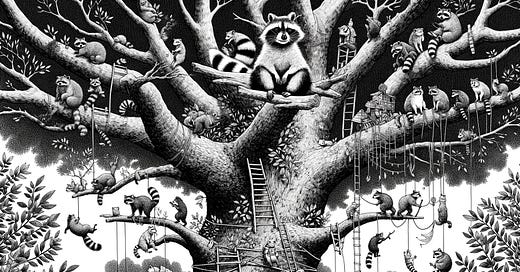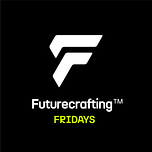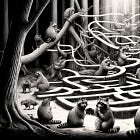Whenever I discuss "Value Chains" with clients, peers, or fellow creative leaders, their eyes light up, revealing a deep need for change. This has prompted me to launch a series of articles titled "The Value Method".
Let the revolution begin.
Caveat
I'll often rely on generalization. It's not out of ignorance for nuance, but to see things that are not visible at a micro scale. While there are exceptions to the rules, and some situations break down once you zoom out too far, it's a worthwhile approach.
When I talk about the creative sector and creatives, I mean solopreneurs, individual professionals, and small and large studios. This ecosystem includes boutique marketing firms, branding shops, design and animation studios, production houses, CG & VFX firms, PR, and event agencies. This is my homeland, an area of my core expertise honed over two decades. Chances are, the patterns I reveal will hold for adjacent sectors, too.
That feeling
How often have you poured your heart and soul into a project, only for the client to respond with a disinterested "meh"? All those late nights, the blood, sweat, and tears — met with indifference. No credit, no recognition. And then, adding insult to injury, you have to chase them down just to get paid, wrecking the remnants of what was supposed to be the beginning of the great friendship.
We've all been there. We know that gut-wrenching feeling. It's not just frustrating; it's soul-crushing. If there's one reason why creative industry leaders burn out and lose their love for what they chose their profession for, it's often this exact scenario. The disconnect, the lack of appreciation, the feeling that all your hard work is undervalued — it takes a toll.
The Creative Industry Is Broken
The current ecosystem within creative firms and their clients suffers from a severe disconnect in recognizing, communicating, and realizing value.
This misalignment hampers the effective Value Flow, leading to missed opportunities and suboptimal outcomes for both parties, to put it mildly.
Before we dissect what's specifically broken, and why, let's look into assumptions that lead to the status quo, and set the stage for deeper exploration.
Assumption #1 - Clients understand the value of creative work.
We assume that clients are aware of the importance and impact of creative services. In reality, many clients still see creative work as a cost rather than an investment. It's a long-standing battle. Without a doubt, over the last three decades, the role of design and design thinking in the corporate world has improved. Design has been assimilated and normalized. It's a significant step, but from a wider perspective, the issue persists — assimilation of design has not automatically propagated and elevated everything else creative.
Assumption #2 - Creatives are confident in communicating the value they create.
We assume that creative professionals can easily articulate the value they bring. Sometimes it's true. But more often — not. Whether we look at newborn creatives entering the space, or established firms selling millions of dollars worth of service.
Many creatives struggle with understanding where the value lies, and what value they bring to the table. If there's a problem in recognizing value, the difficulty in articulation only reinforces its severity. We haven't been trained in understanding, recognizing, and articulating value. And we don't have role models.
Need an example? Open LinkedIn, Behance, Instagram, or a website portfolio of any firm. Solo creatives? The work is shared in posts that lack a single verb, not to mention any meaningful sentence to paint a context, problem, solution, and impact of the work produced. We still believe that "the work speaks for itself", but this statement has never been true.
It's not just creatives. It's equally true once we look at the portfolio of established studios — often the work is presented as a summarization of deliverables, in a self-serving manner, accompanied by grandiose vocabulary and client praise. The business results? Forget about it. The impact? Rarely. We still use a borrowed term "case study", but apply it to a gallery display of pixels with no meaning.
If we don't understand the value of what we create, how can we project it outwards, and use it as leverage in negotiations?
The epidemic of "benchmarking", which is mindlessly giving up on our main prowess — creative and critical thinking, and replacing it with copying references, clearly reveals its impact in this area.
No need to reinvent the wheel — just look at some old good ad or marketing agencies, and you'll notice their case studies often truly state not just the outcome, but the impact of the work done.
Assumption #3 - Procurement processes are efficient and straightforward.
We assume that the process of hiring and working with creative firms is smooth and efficient. But it isn't. In reality, Established, and rarely questioned procurement procedures, bureaucratic hurdles, and misaligned incentives often complicate the process, leading to erosion of the value of the creative work, long before it happens. Procurement teams buy the creative the same way they order office chairs and french fries. For every penny saved, creative buyers get a salary boost, but pretty much everyone else loses — the company ordering it, the creatives, the impact, and the ecosystem. It's plain wrong.
Shoutout to Blair Enns for committing a significant chunk of his career to exploring and fixing these issues. "20% - The Marketing Procurement Podcast" explores these problems from a variety of perspectives.
What's broken?
Issue #1 — Lack of Alignment on Value
There is a significant gap in understanding what constitutes value between clients and creatives. We'll call it The Value Gap.
We, creatives, are particularly connected to what we create — there's love, craft, and commitment, there's taste, artistic sensibility… you name it. All these things make us emotionally invested in the work we do. Way more than in any other profession.
That leads to a significant Value Bias in how the value created is perceived by the creative side: we tend to assume that it is in the pictures, words, or sounds we craft. We never question this assumption. But is it really there?
Value is in the eye of the beholder.
Not nearly so. Are you ready for the cognitive shift?
Value is in the eye of the beholder.
The client may be expecting absolutely different things than what you think they do. It may be that they value meeting the deadline much higher, than having it pixel-perfect. They may want a piece for the only purpose of kicking a competitor's butt, but you won't read about it in the brief. I could go on and on… You probably follow.
The problem is, that besides basic alignment on the brief, the price, and the deadline, the real expectations are rarely explored deeply.
Why? Simply because it's not easy. And the conditions are rarely right.
As with most projects, this one started with a delay anyway, you're desperate to close it or clear it, there's that dreaded bidding process, and generally the way it starts remains more of a tornado, than a beginning of a beautiful friendship.
The single biggest problem in communication is the illusion that it has taken place — George Bernard Shaw.
Ultimately, everyone's fed up with how much this drags, and ready to assume we're on the same page just for the sake of moving ahead.
We assume we're aligned. But we're not.
Have we talked about the criteria of how do we know the project is successful? More often than not, we assume that it's delivering on time, on budget, and getting approval.
"As long as you stay on a brief, we're in a good place". I heard it more than once running my creative firms. And quickly learned it's a red flag, signaling that things are about to go off track.
Had we fully and truly aligned on the expectations and criteria for the success of the project, would we be seeing and fighting desperately to get out of the endless revision loops? Would we be praying for the deadline to be our salvation? Would we be getting sign-off and payment delays?
Why is it a problem?
This misalignment leads to unmet expectations and unsatisfactory project outcomes. The time is wasted, the budget is burnt, the teams are frustrated, and so are clients. The impact is lost, and so is love.
Issue #2 — Lack of Recognition of Value
Both clients and creatives fail to recognize the true value being exchanged. Without proper recognition, it’s challenging to price, negotiate, and justify the creative work, leading to undervaluation and mistrust.
We think it's deliverables and formats, forgetting about the transformative nature of the creative, and the impact it can make.
Issue #3 — Systemic Problems in Realizing Value
In a society running on an economy dominated by left-hemisphere, systems and processes, the creative potential becomes painfully restricted. Add corporate hierarchies, and data-driven-obsessions fueling past-oriented decision making, and all of a sudden, the entire system is wired to win discussions, not to creatively solve problems. Add the marketing procurement issue, and we have a recipe for disaster, more than an ecosystem benefitting from the true power of creative solutions.
We're so much caught up in the battles we fight, whether on the client side, on the creative side, or in between, that the real value of what's being done flees and finally disappears in a dense fog.
These systemic issues create adversarial incentives and pressure, reducing the potential impact of creative work.
These issues collectively result in a broken system where the potential of creative work is not fully realized, leading to frustration and inefficiency on both sides.
Why is it all broken?
Now, that we know what's broken, let's think about why. I'll tackle it from the creative perspective, and follow with the clients'.
#1 - Understanding of the Value Chain
Creative firms often lack clarity about their position in the Value Chain and how it looks in its entirety.
They operate with a narrow context window, and the business ecosystem map is drawn from the perspective of a single ship as they sail. Think of early maps of the Earth, from the times preceding the era of the great expeditions. They were fragmentary and often ludicrous, but we only see that knowing how the globe looks today, as charted by the greats over the years, and then captured from space.
Back to Value Chain, I introduced this concept a couple of articles back — in a nutshell, it is a layered ecosystem of firms and services, collaborating in a connected, often hierarchical way. The bottom layers are usually executional and efficiency-oriented. The farther to the top, the more strategic insight, risk, and value we find.
This concept proves invaluable when I advise creative firms looking for avenues for growth. It gives a simple, visual framework to understand the game we play, and intuitive, yet efficient mechanics to work with.
What a map is it? What is its topology? And complexity? Is it hierarchical? Who are the key players? What is their role and what are they looking for? How much leeway there is at each of the nodes? How is the value created and augmented as we go through the layers? And where are we in this value chain?
Once we unearth the shape of the map and plot our position on it, we're empowered to take meaningful, intentional steps. Do we stay where we are, but empowered with clarity, start crafting targeted value? Or, perhaps, we want to move or branch out laterally? Maybe we want to add strategic capability and climb to the top?
And lastly — does it even make sense for us to stick to this map? They say the grass is greener on the other side. Why don't we look for luck elsewhere?
When you lack the map of the business ecosystem, how can you come up with a meaningful, structured plan for growth, marketing and new business?
It's like entrusting your balls to a surgeon, who doesn't have the basics of human anatomy. As reckless as dangerous. Yet, that's the reality so many firms operate in.
#2 Recognizing Value We Create
Creative firms are rarely built top-down. Typically, things start from the bottom and progress up. That is, they're not built by the business people. They're built by the creatives, that add a business component as they grow. Of course, at a certain threshold, business-savvy folks get hired, to spearhead leadership and rock operations.
For this reason, until a certain point, they often operate with limited business knowledge, business and pricing models, market understanding, and perspective.
Lack of confidence and limiting beliefs hinder their ability to recognize and articulate the value they create.
#3 Communicating the Value
Even if we have clarity on the value that we create, often we lack the skills to articulate with impact. This stems from a lack of business experience, and more specific deficits, such as insufficient understanding of branding and communications, PR, or experience in negotiations.
These gaps shine bright in both directions — firstly concerning outward, public communications, as exampled by building portfolios, case studies or decks, and secondly — in the context of one-on-one negotiations on the front of new business, sales, and client relationships.
That's one of the reasons behind the proliferation of cookie-cutter websites filled with cliche, nonsense copywriting, often coming from established firms. In the case of newcomers or less progressive shops, this results in parroting peers and competitors without understanding the unique value proposition.
On an interactive communications front — it often touches on the fear of discussing money and hesitation to ask clients about their real needs, and the bigger aspirations and goals of the work to be done, spreading beyond the fragmentary reality covered in briefs.
#4 Recognition of Value by Clients
Lastly, there's a range of problems on the client side that stand in the way of recognizing and realizing the full value of creative, with corporate hierarchies, power dynamics, risk management, information flow, and the never-evolved system of buying creative work.
The creative is often specialized and complex. After all, that's what you call experts for. A creative team on a client side may get it, at least in broad strokes. Perhaps even the leadership is aligned. But how can this system work in favor of true value, if these bold goals and calls for the extraordinary are spilled into the brief, and once the bid lands in, they get decapitated by the procurement?
The downward pressure on price and terms of purchasing creative services is in an adversarial relationship with the creative process, and possible impact for the very company ordering the creative.
Conclusions
These issues collectively result in a broken system where the potential of creative work is not fully realized, leading to frustration and inefficiency on both sides.
In the next articles, we'll try to see the possibility of a better world, and explore how looking at the problem from the perspective of Value Chains, Value Flow, and Value Alignment can help unclog the creative arteries.
Stay prolific,
Till the next one!















Share this post